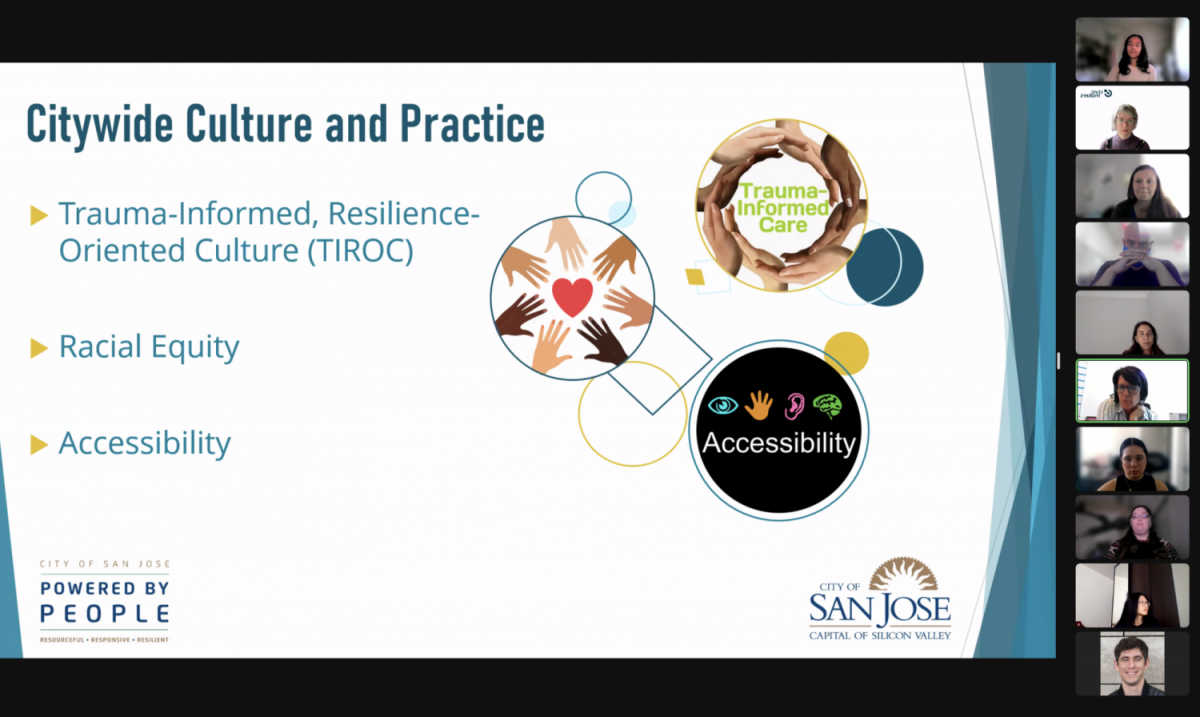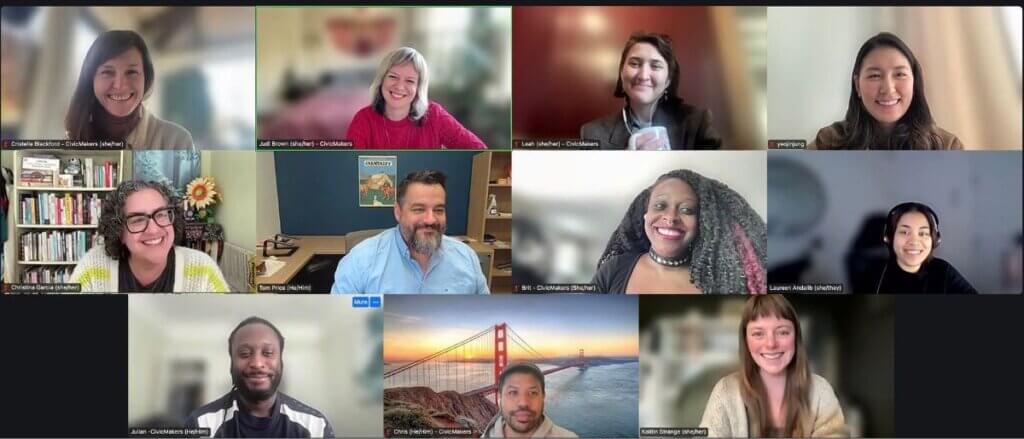Commitments to Inclusive & Accessible Learning Space
Reflections on 2 years of Learning Labs with the City of San José

Cohort 5 Demo Day - Introduction and Context Setting from HR
It’s been two years since we piloted our Learning Lab at the City of San José – how the time flies! Since then, we have worked with 6 cross-departmental cohorts – meaning over 100 people, across 16 departments, have explored 21 different City challenges through the lens of human-centered design.
With each cohort we learn more about the City of San José; we learn more about how human-centered design can give employees new tools in service of the community; and we learn more about how to teach and facilitate what our partners call a safe and brave space. I’m excited to share what we’ve learned, and how we are integrating those learnings into our ongoing work.
Nurturing an Inclusive & Accessible Space
When we mention safe and brave space, we don’t particularly mean ‘comfortable’. We mean a space that provides the real and psychological safety to practice and fail, to be vulnerable, to step outside your comfort zone.
(For more on psychological safety, here’s one of our favorite resources: The five keys to a successful Google team)
Some of the ingredients for a psychologically safe space start with our partners:
- The tone set by our client. The Learning & Development team at the City have consistently invested their time and partnership to thoughtfully and intentionally develop this program.
- The curiosity and encouragement of Learning Lab participants. At the start of each cohort, we share and co-design Learning Environment Agreements to make sure everyone is showing up in a way that supports each other.
As trainers, we are responsible for the remaining ingredients: accessible activities and materials; trauma-informed facilitation; and adaptive program design. With each iteration, we are focussed on the question of ‘how might we ensure the Learning Lab environment is inclusive and accessible?’
Commitments to Inclusive & Accessible Learning Space
We know that continuous growth comes from defining, testing and refining our practice, and we do our best to make the space for this growth in our work. Below, we’ve listed out the commitments that we’ve made to create an inclusive and accessible Learning Lab, followed by a description of some of the actions we have taken to fulfill those commitments.
The Learning Lab Provides:
1. A safe environment to practice and step out of one’s comfort zone
Instead of a class environment where there are right and wrong answers
2. Activities and materials that are accessible, regardless of whether one is familiar with Human-Centered Design or the tools
Instead of a steep learning curve to be able to participate
3. Clear instruction and context around activities to be able to show up feeling prepared
Instead of unclear processes or activities that are hard to make sense of in real time
4. A constructive and inviting space to share and contribute
Instead of mandatory participation or pressure to share reflections on the spot
5. Resources that support various learning styles
Instead of one structure that either works for you or it doesn’t
Commitments in Action
Note – some of these applications are specific to the City of San José and the tools that they use (ex: Microsoft Suite).
1. A safe environment to practice and step out of one’s comfort zone
- Create teams that can work together toward a common goal as opposed to focusing on individual contributions
- Activities that support a shared goal as opposed to creating busywork
- Make meaningful use of the Learning Lab sessions – providing blocks of time for teams to complete work and minimize the tasks that have to be completed outside of the Lab session
- Offer coaching sessions where trainers can support teams through the process and provide more personalized instruction
- Maintain consistent structure to sessions so that participants can know what to expect
2. Activities and materials that are accessible, regardless of whether one is familiar with HCD or the tools
- Use familiar tools that meet accessibility standards (e.g. Microsoft tools at the City of San José)
- Check the accessibility of materials in Microsoft Word before sharing with teams
- Identify and replace ableist language from topic descriptions and instructions
- Ask about accessibility accommodations at sign-up to make sure anyone that signs up has their needs met during the program
- Share accessibility commitments in advance to reduce the need for people to disclose disability-related information
- Create private channels for people to share any needs that may arise during the program – acknowledging that environments can create unforeseen barriers
- Enable live transcription in zoom and make sure to leave the Main Room open during breakout sessions for any participants who are using the transcript (for as long as the transcript remains unavailable in breakout rooms)
3. Clear instruction and context around activities to be able to show up feeling prepared
- Share session materials the day before a training session to make sure people have enough time to review / download / print, as desired
- Have clear slides that list out instructions, and copy key details into the chat so that they can be referenced even in breakout rooms
- Include plain language instructions on materials – ensuring they match instructions on the slides
4. A constructive and inviting space to share and contribute
- Use the ‘raise hand’ feature in zoom to invite people to share when they’re ready
- Read aloud comments that are shared in the chat, and invite folks to expand upon what they wrote
- Avoid calling on people that haven’t signaled interest in sharing
- Encourage – but do not require – folks to join on camera and off mute during activities
5. Resources that support various learning styles
- Provide opportunities for theory, case studies, and practice during sessions, as well as reference materials that are available outside of sessions
- Provide opportunities for individual reflection as well as group discussion
- Summarize and repeat key topics and tips
- Offer breaks (10 minutes, preferably) at 50 minute intervals
Next Steps
There is always more to learn about designing for inclusion and accessibility. As a team, we commit to reflexive practice – listening, reflecting, and continuing to build on everything we’ve learned so far.
With every Learning Lab we have a chance to test and refine our commitments. Every time we revisit our curriculum and our materials is an opportunity to integrate insights:
- From movements toward racial equity, trauma-informed practices, and accessibility. Some sources for reflection and references for this work include (but by no means are limited to):
- Aorta (Anti-Oppression Resource & Training Alliance)
- Trauma-Informed Facilitation (Mary-Margaret Sweeney, Facilitating XYZ)
- Ableism is not “bad words.” It’s violence. & Violence in Language: Circling Back to Linguistic Ableism (Lydia X.Z. Brown)
- Resources from SF Human Services Agency’s Accessibility Standards and Guidelines
- Vendor resources from the City of San José (and our other clients) on how to ensure training programs are safe and accessible
- From out ‘in the field’ – insights from our work alongside communities and practitioners to co-design meaningful and inclusive convenings (Ex: Practicing Accessible Design in Community Development).
- What we learn from continued Learning Labs and training. Thank you to training participants – past and present – for helping us to continuously improve by showing up, engaging, and giving us feedback on our programs and resources. We appreciate every opportunity we get to learn alongside you!
I look forward to sharing more as we continue our journey to more inclusive and accessible ‘space-making.’



